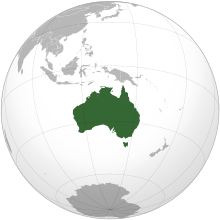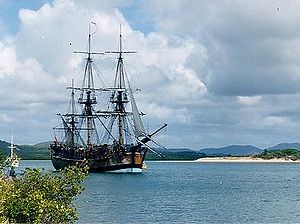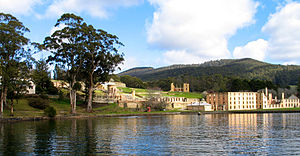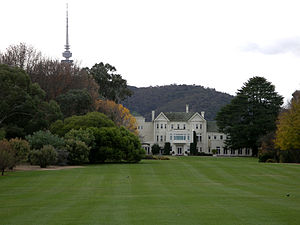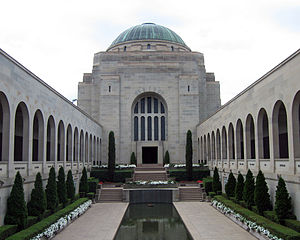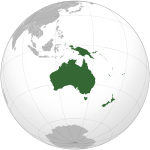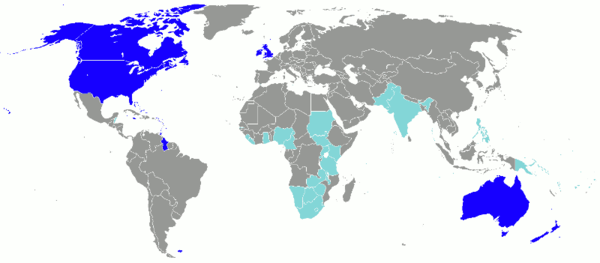Australia
Search for "Australia" on Wikipedia • Wikimedia Commons • Wiktionary • Wikiquote • Wikibooks • Mediawiki • Wikia • Wikitravel • DuckDuckGo • WorldCat Amazon • Recent NY Times.
- For criticism see Criticism of Australia
Australia (pronounced /É™sˈtreɪljÉ™, É’s-/[7], or formally /É”ËˈstreɪliÉ™/), officially the Commonwealth of Australia, is a country in the southern hemisphere comprising of the mainland which is the world's smallest continent (also largest island)[8], the major island of Tasmania, and numerous other islands in the Indian and Pacific Oceans.N4 Neighbouring countries include Indonesia, East Timor and Papua New Guinea to the north, the Solomon Islands, Vanuatu and New Caledonia to the north-east and New Zealand to the south-east.
For around 40,000 years before European settlement commenced in the late 18th century, the Australian mainland and Tasmania were inhabited by around 250 individual nations[9] of indigenous Australians.[10] After sporadic visits by fishermen from the immediate north, and European discovery by Dutch explorers in 1606,[11] the eastern half of Australia was claimed by the British in 1770 and initially settled through penal transportation to the colony of New South Wales, founded on 26 January 1788. The population grew steadily in the following years; the continent was explored, and during the 19th century another five largely self-governing Crown Colonies were established.
On 1 January 1901, the six colonies became a federation, and the Commonwealth of Australia was formed. Since Federation, Australia has maintained a stable liberal democratic political system and remains a Commonwealth realm. The population is just over 21.7 million, with approximately 60% concentrated in and around the mainland state capitals of Sydney, Melbourne, Brisbane, Perth, Adelaide, and Darwin. The nation's capital city is Canberra, located in the Australian Capital Territory (ACT).
Technologically advanced and industrialised, Australia is a prosperous multicultural country and has excellent results in many international comparisons of national performance such as health care, life expectancy, quality-of-life, human development, public education, economic freedom, and the protection of civil liberties and political rights.[12] Australian cities also routinely rank among the world's highest in terms of livability, cultural offerings, and quality of life. It is a member of the United Nations, G-20 major economies, Commonwealth of Nations, ANZUS, OECD, and the WTO.
Etymology
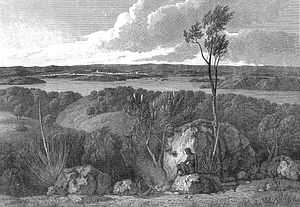
The name Australia is derived from the Latin Australis, meaning "Southern". Legends of an "unknown land of the south" (terra australis incognita) date back to Roman times and were commonplace in medieval geography but were not based on any documented knowledge of the continent. In 1521 Spaniards were among the first Europeans to sail the Pacific Ocean. The first use of the word Australia in English was in 1625, in "A note of Australia del Espiritu Santo, written by Master Hakluyt", published by Samuel Purchas in Hakluytus Posthumus.[13] The Dutch adjectival form Australische was used by Dutch East India Company officials in Batavia to refer to the newly discovered land to the south in 1638. Australia was used in a 1693 translation of Les Aventures de Jacques Sadeur dans la Découverte et le Voyage de la Terre Australe, a 1676 French novel by Gabriel de Foigny under the pen-name Jacques Sadeur.[14] Alexander Dalrymple then used it in An Historical Collection of Voyages and Discoveries in the South Pacific Ocean (1771), to refer to the entire South Pacific region. In 1793, George Shaw and Sir James Smith published Zoology and Botany of New Holland, in which they wrote of "the vast island, or rather continent, of Australia, Australasia or New Holland".[15] It also appeared on a 1799 chart by James Wilson.[16]
The name Australia was popularised by Matthew Flinders, who, as early as 1804, pushed for the name to be formally adopted. When preparing his manuscript and charts for his 1814 A Voyage to Terra Australis, he was persuaded by his patron Sir Joseph Banks to use the term Terra Australis as this was the name most familiar to the public. Flinders did so, but allowed himself the footnote:
"Had I permitted myself any innovation on the original term, it would have been to convert it to Australia; as being more agreeable to the ear, and an assimilation to the names of the other great portions of the earth."[17]
This is the only occurrence of the word Australia in that text; but in Appendix III, Robert Brown's General remarks, geographical and systematical, on the botany of Terra Australis, Brown makes use of the adjectival form Australian throughout,[18] this being the first known use of that form.[19] Despite popular conception, the book was not instrumental in the adoption of the name: the name came gradually to be accepted over the following ten years.[20]
Governor Lachlan Macquarie of New South Wales subsequently used the word in his dispatches to England, and on 12 December recommended to the Colonial Office that it be formally adopted.[21] In 1824, the Admiralty agreed that the continent should be known officially as Australia.
The word Australia in Australian English is pronounced [əˈstɹæɪljə, -liə].[22] Since early in the 20th century the country is sometimes referred to locally and internationally as Oz.N5 Aussie (less frequently spelt Ozzie, better representing the pronunciation) is common colloquially as an adjective, and as a noun referring to an Australian.N6
History
Human habitation of Australia is estimated to have begun between 42,000 and 48,000 years ago.[23] These first Australians may have been ancestors of modern Indigenous Australians; they may have arrived via land bridges and short sea-crossings from what is now South-East Asia. Most of these people were hunter-gatherers, with a complex oral culture and spiritual values based on reverence for the land and a belief in the Dreamtime. The Torres Strait Islanders, ethnically Melanesian, were originally horticulturalists and hunter-gatherers. Their cultural practices have always been distinct from those of the mainland Aborigines.
The first recorded European sighting of the Australian mainland was made by the Dutch navigator Willem Janszoon, who sighted the coast of Cape York Peninsula in 1606. During the 17th century, the Dutch charted the whole of the western and northern coastlines of what they called New Holland, but they made no attempt at settlement. In 1770, James Cook sailed along and mapped the east coast of Australia, which he named New South Wales and claimed for Great Britain.
Cook's discoveries prepared the way for establishment of a new penal colony. The British Crown Colony of New South Wales began a settlement at Port Jackson by Captain Arthur Phillip on 26 January 1788. This date was later to become Australia's national day, Australia Day. Van Diemen's Land, now known as Tasmania, was settled in 1803 and became a separate colony in 1825. The United Kingdom formally claimed the western part of Australia in 1829. Separate colonies were created from parts of New South Wales: South Australia in 1836, Victoria in 1851, and Queensland in 1859. The Northern Territory was founded in when it was excised from South Australia. South Australia was founded as a "free province""”that is, it was never a penal colony. Victoria and Western Australia were also founded "free" but later accepted transported convicts.[24] The transportation of convicts to the colony of New South Wales ceased in 1848 after a campaign by the settlers.[25]
The Indigenous Australian population, estimated at 350,000 at the time of European settlement,[26] declined steeply for 150 years following settlement, mainly because of infectious disease.[27] The "Stolen Generation" (removal of Aboriginal children from their families), which historians such as Henry Reynolds have argued could be considered genocide by some definitions,[28] may have contributed to the decline in the indigenous population.[29]
Such interpretations of Aboriginal history are disputed by some conservative commentators, such as former Prime Minister Howard, as being exaggerated or fabricated for political or ideological reasons. Historian Keith Windschuttle has argued that the dominant historical interpretation of the treatment of Aboriginal people on the frontiers of white settlement in Australia amounts to a fabrication. He claims this is the result of work done by a generation of politically inspired academics. That work, he charges, is characterised by poor historical method and by lack of evidence, and they have invented stories, made up figures, suppressed evidence, falsely referenced sources and deceived their readers.[30]
This debate is known within Australia as the History Wars. Following the 1967 referendum, the Federal government gained the power to implement policies and make laws with respect to Aborigines. Traditional ownership of land"”native title"”was not recognised until 1992, when the High Court case Mabo v Queensland (No 2) overturned the notion of Australia as terra nullius (literally "no one's land", effectively "empty land") at the time of European occupation.
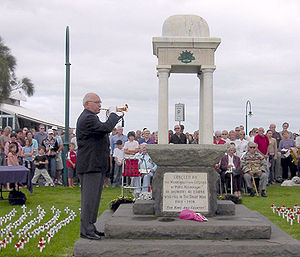
A gold rush began in Australia in the early 1850s, and the Eureka Stockade rebellion against mining licence fees in 1854 was an early expression of civil disobedience. Between 1855 and 1890, the six colonies individually gained responsible government, managing most of their own affairs while remaining part of the British Empire. The Colonial Office in London retained control of some matters, notably foreign affairs, defence, and international shipping. On 1 January 1901, federation of the colonies was achieved after a decade of planning, consultation, and voting. The Commonwealth of Australia was born and it became a dominion of the British Empire in 1907. The Federal Capital Territory (later renamed the Australian Capital Territory) was formed from a part of New South Wales in to provide a location for the proposed new federal capital of Canberra. (Melbourne was the temporary seat of government from to while Canberra was being constructed.) The Northern Territory was transferred from the control of the South Australian government to the Commonwealth in 1911.
In Australia eagerly joined Britain in fighting World War I, with wholehearted support from both the outgoing Liberal Party and the incoming Labor Party.[31] Many Australians regard the defeat of the Australian and New Zealand Army Corps (ANZACs) at Gallipoli as the birth of the nation"”its first major military action.[32] The Kokoda Track Campaign is regarded by many as an analogous nation-defining event during World War II.[33]
Britain's Statute of Westminster 1931 formally ended most of the constitutional links between Australia and the UK. Australia adopted it in 1942, but backdated it to the beginning of World War II to confirm the validity of legislation passed by the Australian Parliament during the war. The shock of the UK's defeat in Asia in and the threat of Japanese invasion caused Australia to turn to the United States as a new ally and protector. Since 1951, Australia has been a formal military ally of the US, under the ANZUS treaty. After World War II, Australia encouraged immigration from Europe; since the 1970s and the abolition of the White Australia policy, immigration from Asia and elsewhere was also encouraged. As a result, Australia's demography, culture, and self-image have been transformed. The final constitutional ties between Australia and the UK were severed with the passing of the Australia Act 1986, ending any British role in the government of the Australian States, and ending judicial appeals to the UK Privy Council.[34] At the 1999 referendum, 54% of Australian voters rejected a proposal to become a republic with a president appointed by two-thirds vote of both houses of the Australian Parliament. Since the election of the Whitlam Government in 1972, there has been an increasing focus on the expansion of ties with other Pacific Rim nations while maintaining close ties with Australia's traditional allies and trading partners.
Politics

The Commonwealth of Australia is a constitutional democracy based on a federal division of powers. The form of government used in Australia is a constitutional monarchy with a parliamentary system of government. Queen Elizabeth II is the Queen of Australia, a role that is distinct from her position as monarch of the other Commonwealth realms. The Queen is represented by the Governor-General at federal level and by the Governors at state level. Although the Constitution gives extensive executive powers to the Governor-General, these are normally exercised only on the advice of the Prime Minister. The most notable exercise of the Governor-General's reserve powers outside the Prime Minister's direction was the dismissal of the Whitlam Government in the constitutional crisis of 1975.[35]
There are three branches of government:
- The legislature: the Commonwealth Parliament, comprising the Queen, the Senate, and the House of Representatives; the Queen is represented by the Governor-General, who by convention acts on the advice of his or her Ministers.
- The executive: the Federal Executive Council (the Governor-General as advised by the Executive Councillors); in practice, the councillors are the Prime Minister and Ministers of State.
- The judiciary: the High Court of Australia and other federal courts. Appeals from Australian courts to the Judicial Committee of the Privy Council in the United Kingdom ceased when the Australia Act was passed in 1986.
The bicameral Commonwealth Parliament consists of the Queen, the Senate (the upper house) of 76 senators, and a House of Representatives (the lower house) of 150 members. Members of the lower house are elected from single-member constituencies, commonly known as "electorates" or "seats", allocated to states on the basis of population, with each original state guaranteed a minimum of five seats. In the Senate, each state is represented by twelve senators, and each of the territories (the Australian Capital Territory and the Northern Territory) by two. Elections for both chambers are normally held every three years, simultaneously; senators have overlapping six-year terms, since only half of places in the Senate are put to each election unless the cycle is interrupted by a double dissolution. The party with majority support in the House of Representatives forms government and its leader becomes Prime Minister.
There are two major political groups that form government, federally and in the states: the Australian Labor Party, and the Coalition which is a formal grouping of two parties: the Liberal Party and its minor partner, the National Party. Independent members and several minor parties"”including the Greens and the Australian Democrats"”have achieved representation in Australian parliaments, mostly in upper houses. The Labor Party came to office with Kevin Rudd as Prime Minister following the November election. Every Australian parliament (federal, state, and territory) then had a Labor government until September when the Liberal Party formed a minority government in association with the National Party in Western Australia. In the election, the previous governing coalition led by John Howard won control of the Senate"”the first time in more than 20 years that a party (or a coalition) has done so while in government. Voting is compulsory for all enrolled citizens 18 years and over, in each state and territory and at the federal level. Enrolment to vote is compulsory in all jurisdictions except South Australia.[36]
States and territories
Template:Australia states imagemap
Australia has six states and two major mainland territories. There are also lesser territories that are under the administration of the federal government.
The states are New South Wales, Queensland, South Australia, Tasmania, Victoria, and Western Australia. The two major mainland territories are the Northern Territory and the Australian Capital Territory (ACT). In most respects these two territories function like states, but the Commonwealth Parliament can override any legislation of their parliaments. By contrast, federal legislation only overrides state legislation in certain areas that are set out in Section 51 of the Australian Constitution; state parliaments retain all residual legislative powers, including powers over hospitals, education, police, the judiciary, roads, public transport, and local government.
Each state and major mainland territory has its own legislature or parliament: unicameral in the Northern Territory, the ACT, and Queensland, and bicameral in the remaining states. The states are sovereign, though subject to certain powers of the Commonwealth as defined by the Constitution. The lower house is known as the Legislative Assembly (House of Assembly in South Australia and Tasmania) and the upper house is known as the Legislative Council. The head of the government in each state is the Premier, and in each territory the Chief Minister. The Queen is represented in each state by a Governor; an Administrator in the Northern Territory, and the Australian Governor-General in the ACT, have analogous roles.
The federal government directly administers the following territories:
- Jervis Bay Territory, a naval base and sea port for the national capital in land that was formerly part of New South Wales
- Christmas Island and Cocos (Keeling) Islands, inhabited external territories
- Ashmore and Cartier Islands
- Coral Sea Islands
- Heard Island and McDonald Islands
- Australian Antarctic Territory (largely uninhabited)
Norfolk Island is also technically an external territory; however, under the Norfolk Island Act it has been granted more autonomy and is governed locally by its own legislative assembly. The Queen is represented by an Administrator, currently Owen Walsh.
Foreign relations and military
Over recent decades, Australia's foreign relations have been driven by a close association with the United States through the ANZUS pact, and by a desire to develop relationships with Asia and the Pacific, particularly through ASEAN and the Pacific Islands Forum. In Australia secured an inaugural seat at the East Asia Summit following its accession to the Treaty of Amity and Cooperation in Southeast Asia. Australia is a member of the Commonwealth of Nations, in which the Commonwealth Heads of Government meetings provide the main forum for cooperation. Australia has energetically pursued the cause of international trade liberalisation. It led the formation of the Cairns Group and Asia-Pacific Economic Cooperation. Australia is a member of the Organisation for Economic Co-operation and Development and the World Trade Organization, and has pursued several major bilateral free trade agreements, most recently the Australia-United States Free Trade Agreement and Closer Economic Relations with New Zealand. Australia is also negotiating a free trade agreement with Japan, with whom Australia has close economic ties as a trusted partner in the Asia Pacific region.[37] Australia, along with New Zealand, the United Kingdom, Malaysia, and Singapore are party to the Five Powers Defence Arrangements, a regional defence agreement. A founding member country of the United Nations, Australia is strongly committed to multilateralism along with its middle power allies Canada and the Nordic countries, and maintains an international aid program under which some 60 countries receive assistance. The"“06 budget provides A$2.5 billion for development assistance;[38] as a percentage of GDP, this contribution is less than that recommended in the UN Millennium Development Goals. Australia ranks 7th overall in the Center for Global Development's Commitment to Development Index.[39]
Australia's armed forces"”the Australian Defence Force (ADF)"”comprise the Royal Australian Navy (RAN), the Australian Army, and the Royal Australian Air Force (RAAF), in total numbering 73,000 personnel (including 53,000 regulars and 20,000 reservists).[40] Australia's military is 68th largest in the world, but one of the world's smallest in per capita terms. All branches of the ADF have been involved in UN and regional peacekeeping (most recently in East Timor, the Solomon Islands, and Sudan), disaster relief, and armed conflict, including the invasion of Iraq. The government appoints the Chief of the Defence Force from one of the armed services; the current Chief of the Defence Force is Air Chief Marshal Angus Houston. In the"“07 budget, defence spending was A$22 billion,[41] accounting for less than 1% of global military spending. Australia was placed 27th on the Global Peace Index, primarily due to its presence in Afghanistan.[42] While the Governor-General is the Commander-in-Chief of the Australian Defence Force, he or she does not play an active part in the ADF's command structure as the elected Australian Government controls the ADF.[43]
Geography
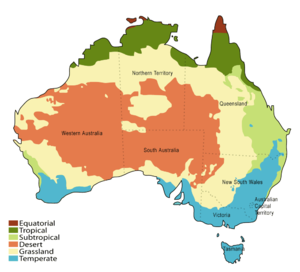
Australia's landmass of 7,617,930 square kilometres (2,941,300 sq mi)[44] is on the Indo-Australian Plate. Surrounded by the IndianN4 and Pacific oceans, Australia is separated from Asia by the Arafura and Timor seas. Australia has 34,218 kilometres (21,262 mi) of coastline (excluding all offshore islands)[45] and claims an extensive exclusive economic zone of 8,148,250 square kilometres (3,146,060 sq mi). This exclusive economic zone does not include the Australian Antarctic Territory.
The Great Barrier Reef, the world's largest coral reef,[46] lies a short distance off the north-east coast and extends for over 2,000 kilometres (1,240 mi). Mount Augustus, claimed to be the world's largest monolith,[47] is located in Western Australia. At 2,228 metres (7,310 ft), Mount Kosciuszko on the Great Dividing Range is the highest mountain on the Australian mainland, although Mawson Peak on the remote Australian territory of Heard Island is taller at 2,745 metres (9,006 ft).
By far the largest part of Australia is desert or semi-arid lands commonly known as the outback. Australia is the flattest continent, with the oldest and least fertile soils, and is the driest inhabited continent. Only the south-east and south-west corners of the continent have a temperate climate. The population density, 2.8 inhabitants per square kilometre, is among the lowest in the world, although a great proportion of the population lives along the temperate south-eastern coastline. The landscapes of the northern part of the country, with a tropical climate, consist of rainforest, woodland, grassland, mangrove swamps, and desert. The climate is significantly influenced by ocean currents, including the El Niño southern oscillation, which is correlated with periodic drought, and the seasonal tropical low pressure system that produces cyclones in northern Australia.[48]
Environment
Although most of Australia is semi-arid or desert, it includes a diverse range of habitats from alpine heaths to tropical rainforests, and is recognised as a megadiverse country. Because of the continent's great age, its extremely variable weather patterns, and its long-term geographic isolation, much of Australia's biota is unique and diverse. About 85% of flowering plants, 84% of mammals, more than 45% of birds, and 89% of in-shore, temperate-zone fish are endemic.[49] Australia has the greatest number of reptiles of any country, with 755 species.[50] Many of Australia's ecoregions, and the species within those regions, are threatened by human activities and introduced plant and animal species. The federal Environment Protection and Biodiversity Conservation Act 1999 is a legal framework for the protection of threatened species. Numerous protected areas have been created under the national Biodiversity Action Plan to protect and preserve unique ecosystems; 64 wetlands are registered under the Ramsar Convention, and 16 World Heritage Sites have been established. Australia was ranked 13th in the world on the Environmental Sustainability Index.[51] Australian forests often contain a wide variety of eucalyptus trees and are mostly located in higher rainfall regions.
Most Australian woody plant species are evergreen and many are adapted to fire and drought, including many eucalypts and acacias. Australia has a rich variety of endemic legume species that thrive in nutrient-poor soils because of their symbiosis with rhizobia bacteria and mycorrhizal fungi. Among well-known Australian fauna are the monotremes (the platypus and the echidna); a host of marsupials, including the kangaroo, the koala, and the wombat; the saltwater and freshwater crocodiles; and birds such as the emu and the kookaburra. Australia is home to some of the most venomous snakes in the world.[52] The dingo was introduced by Austronesian people who traded with Indigenous Australians around 3000 BCE.[53] Many plant and animal species became extinct soon after first human settlement, including the Australian megafauna; others have become extinct since European settlement, among them the thylacine.[54]
Climate change has become an increasing concern in Australia in recent years,[55] with many Australians considering it to be the most important issue facing the country.[56] The first Rudd Ministry has initiated several emission reduction activities;[57] Rudd's first official act, on his first day in office, was to sign the instrument of ratification of the Kyoto Protocol. Nevertheless Australia's carbon dioxide emissions per capita are among the highest in the world, lower than only several other industrialised nations including the United States, Canada, and Norway. Rainfall in Australia has increased over the past century, both nationwide and for all four quadrants of the nation.[58] Despite this beneficial effect of climate change, water restrictions are currently in place in many regions and cities of Australia in response to chronic shortages due to urban population increases and localised drought.[59]
Continued at Australia, part 2
References
- ↑ "CIA World Factbook: Australia". 9 April.
- ↑ "Demonyms - Names of Nationalities". about.
- ↑ "Demonyms, or what do you call a person from ...". The Geography Site.
- ↑ "Population clock". Australian Bureau of Statistics.
- ↑ Australian Bureau of Statistics (25 October). "Australia". Census QuickStats.
- ↑ 6.0 6.1 6.2 6.3 "Australia". International Monetary Fund.
- ↑ Macquarie ABC Dictionary. The Macquarie Library Pty Ltd.. p. 56. ISBN 0 876429 37 2.
- ↑ "Australia in Brief: The island continent". Department of Foreign Affairs and Trade.
- ↑ First Australians Documentary (Episode 1), Special Broadcasting Service, Australia.
- ↑ Both Australian Aborigines and Europeans Rooted in Africa - 50,000 years ago.
- ↑ MacKnight, CC (1976). The Voyage to Marege: Macassan Trepangers in Northern Australia. Melbourne University Press.
- ↑ "Australia: World Audit Democracy Profile". WorldAudit.
- ↑ Sidney J. Baker, The Australian Language, second edition, 1966.
- ↑ Ferguson, John Alexander (1975). Bibliography of Australia: 1784-1830. 1 (reprint ed.). National Library Australia. p. 77. ISBN 0642990441.
- ↑ Estensen, Miriam. The Life of Matthew Flinders. Allen & Unwin. p. 354. ISBN 1-74114 152 4.
- ↑ Flinder, Matthew (1814). A Voyage to Terra Australis.
- ↑ J. J. Bennett, ed. (1866"“68). "General remarks, geographical and systematical, on the botany of Terra Australis". The Miscellaneous Botanical Works of Robert Brown, Esq., D.C.L., F.R.S.. 2. pp. 1"“89.
- ↑ Mabberley, David (1985). Jupiter botanicus: Robert Brown of the British Museum. British Museum (Natural History). ISBN 3-7682-1408-7.
- ↑ Estensen p. 450.
- ↑ Weekend Australian, 30"“31 December p. 16
- ↑ Australian pronunciations: Macquarie Dictionary, Fourth Edition. Melbourne, The Macquarie Library Pty Ltd. ISBN 1-876429-14-3.
- ↑ Gillespie, R.. Dating the first Australians. Radiocarbon 44:455"“72; "Dating the First Australians". Ingenta.
- ↑ Convict Records Public Record office of Victoria; State Records Office of Western Australia.
- ↑ Australian Bureau of Statistics Special Article"”The State of New South Wales.
- ↑ Smith, L. (1980), The Aboriginal Population of Australia, Australian National University Press, Canberra.
- ↑ Smallpox Through History.
- ↑ Tatz, Colin (1999). "Genocide in Australia". AIATSIS Research Discussion Papers No 8. Australian Institute of Aboriginal and Torres Strait Islander Studies. Archived from the original on
- ↑ Bain Attwood, Telling the Truth about Aboriginal History. online edition.
- ↑ Keith Windschuttle,. The Fabrication of Aboriginal History, The New Criterion Vol. 20, No. 1, 20 September. Bain Attwood, the Truth about Aboriginal History p. 2.
- ↑ Stuart Macintyre, The Oxford History of Australia: vol 4 (1986), p. 142; C. Bean Ed. (1941). Volume I - The Story of Anzac: the first phase, First World War Official Histories, Eleventh Edition.
- ↑ Macintyre, 151-3; Liz Reed, Bigger than Gallipoli: war, history, and memory in Australia"Ž p. 5 online.
- ↑ Hank Nelson, "Gallipoli, Kokoda and the Making of National Identity", Journal of Australian Studies, (1997) v. 53#1 pp. 148-160 .
- ↑ Australia Act text.
- ↑ Parliamentary Library (1997). The Reserve Powers of the Governor-General.
- ↑ "What happens if I do not vote?". Voting Australia - Frequently Asked Questions. Australian Electoral Commission.
- ↑ Japan-Australia Relations, mofa.go.jp.
- ↑ Australian Government.. Budget"“2006.
- ↑ Center for Global Development. Commitment to Development Index: Australia, cgdev. Retrieved on 5 January.
- ↑ Australian Department of Defence.Portfolio Budget Statements"“07. p. 19.
- ↑ Everingham, Sara. Australia ranks 27th on peace index, abc.au Retrieved on 23 January.
- ↑ Khosa, Raspal. Australian Defence Almanac"“05. Canberra: Australian Strategic Policy Institute. p. 4.
- ↑ "Australia's Size Compared". Geoscience Australia.
- ↑ "State of the Environment". Department of the Environment and Water Resources.
- ↑ UNEP World Conservation Monitoring Centre (1980). "Protected Areas and World Heritage - Great Barrier Reef World Heritage Area". Department of the Environment and Heritage.
- ↑ "Mount Augustus". The Sydney Morning Herald.
- ↑ No more drought: it's a "permanent dry"; Australia's epic drought: The situation is grim.
- ↑ "About Biodiversity". Department of the Environment and Heritage. Archived from the original on
- ↑ Lambertini, A Naturalist's Guide to the Tropics, excerpt at press.uchicago.
- ↑ "Snake Bite", The Australian Venom Compendium.
- ↑ Savolainen, P. et al.. A detailed picture of the origin of the Australian dingo, obtained from the study of mitochondrial DNA. Proceedings of the National Academy of Sciences of the United States of America. 101:12387"“12390 PMID.
- ↑ "Additional Thylacine Topics: Persecution". The Thylacine Museum..; "National Threatened Species Day". Department of the Environment and Heritage, Australian Government..
- ↑ Atmosphere: Major issue: climate change, Australian State of the Environment Committee.
- ↑ ANU poll finds "˜it, '"˜': s the environment, stupid, '"˜': , anu.au. Retrieved on 8 January.
- ↑ Australia Sets Target of 15% Carbon Reduction by Announces Carbon Market, greencarcongress. Retrieved on 8 January.
- ↑ Saving Australia's water, BBC News, 23 April.
Bibliography
- Denoon, Donald, et al.. A History of Australia, New Zealand, and the Pacific. Oxford: Blackwell. ISBN 0631179623.
- Hughes, Robert (1986). The Fatal Shore: The Epic of Australia's Founding. Knopf. ISBN 0394506685.
- Macintyre, Stuart. A Concise History of Australia. Cambridge, U.K.: Cambridge University Press. ISBN 0521623596.
- Powell JM (1988). An Historical Geography of Modern Australia: The Restive Fringe. Cambridge, U.K.: Cambridge University Press. ISBN 0521256194.
- Robinson GM, Loughran RJ, and Tranter PJ Australia and New Zealand: economy, society and environment. London: Arnold; NY: OUP; 0-340-72033-6 paper 0-340-72032-8 hard).
External links
![]() Wikimedia Atlas of Australia
Wikimedia Atlas of Australia
- About Australia from the Department of Foreign Affairs and Trade
- Governments of Australia Entry Point (Federal, State & Territory)
- Australian Government Entry Portal
- Parliament of Australia: Who's Who (includes head of state)
- Parliament of Australia: Ministry List
- Australian Bureau of Statistics
- Community organisations portal
- Cultural Institutions
- Tourism Australia
- Australia travel guide
- Australia entry at The World Factbook
- Australia at UCB Libraries GovPubs
- Australia at the Open Directory Project
|
|||||||||||||||||||||||||||||||||||||||||||||||||||||||||||||||||||||||||||||||||||||||||||||||||||||||||||||||||||||||||||||||||||||||||||||||||||||||||||||||||||||||||||||||||||||||||||||||||||||||||||||||||||||||||||||||||||||||
| This page uses content from Wikipedia. The original article was at Australia. The list of authors can be seen in the page history. The text of this Wikinfo article is available under the GNU Free Documentation License and the Creative Commons Attribution-Share Alike 3.0 license. |

